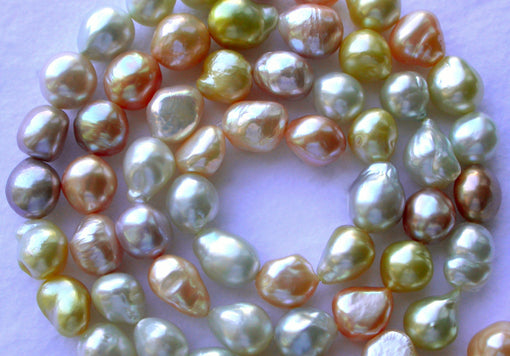
- Article published at:
- Article author: Trimi Trimi
- Article tag: About pearls
- Article comments count: 0
Drawer menu
In this article we will explore the second criterion for classifying cultured pearls: the size of the pearls.
For those who missed the first article in this edition, we suggest that you also read the article on the shape of cultured pearls.
The size of a pearl is represented by the diameter of the pearl in mm and is a very important criterion to take into consideration as it determines both the aesthetic result and the price of the jewel.
As far as the aesthetic aspect is concerned, smaller diameter pearls are ideal for making a minimalist jewel. On the other hand, larger pearls are to be chosen when looking for a more important and more protagonist jewel of the outfit. As an example, we suggest looking at the different aesthetic results of our stud earrings available in different diameters.
As far as the economic aspect is concerned, generally a pearl of a larger diameter is more expensive than one of a smaller diameter with the same quality. However, there may be exceptions dictated by the market, such as excessive demand or low production. Lately we have been seeing a price increase of the smallest sizes: one of the main driving factors is a strong demand from the final consumer.
More technically, the size of the pearls that are commonly marketed ranges from 2.5 to 15 mm in diameter. There are also larger and smaller pearls of a few mm but they tend to be less used. It is important to understand that the diameter is not an absolute transversal factor for each type of pearl but rather each type of pearl is characterized by its own size. This is due to the fact that cultured pearls are a product of natural origin, generated by the pearl oyster. Not all oysters have the same size: oysters of smaller size tend to generate smaller pearls and vice versa. Other influencing factors are the cultivation temperature, the nucleus inserted inside the oyster, the cultivation time…
For example, Australian pearls have a diameter greater than 8mm and can reach considerable dimensions up to 17mm even if a 15mm pearl is already considered large. Tahitian pearls have diameters starting from 7mm and they too reach dimensions as large as 16mm. Instead, Japanese akoya pearls hardly exceed 10mm but can also have very small dimensions such as 3mm.
We report interesting to report that the largest pearl found in the world is 61×30 cm and was found in the Philippines.
To measure the diameter of a pearl, a caliper is used and the size is commonly expressed in millimeters with one or two decimal places. Ex. 6.54mm or 6.5mm. The second decimal digit is not very useful for commercial purposes: it is used in the laboratory during the setting phase, i.e. when pairs of pearls are created to make earrings so as to create the perfect earring.
On the other hand, when you have a lot of pearls of different sizes, you use a sieve like the one in the photo, i.e. metal discs with holes of a diameter equal to the size you want to use as a watershed to divide the pearls.
For example, let's assume we have a mixed batch of pearls ranging from 5mm to 10mm and we want to locate all pearls that are 8-9mm in diameter. In this case we will first use an 8mm sieve which will divide the pearls into two groups, one 5-8mm and one 8-10. At this point we will take a 9mm sieve and pass the 8-10mm pearls, which in turn will divide the pearls into two groups, one of which is 8-9mm.
Soon the next episode always on the classification of pearls: brightness. Stay tuned!